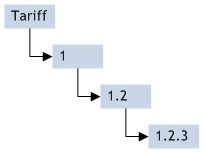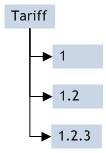Hierarchy Support
Some tariffs filed electronically with FERC are filed in multiple pieces or tariff records. Gas industry open access tariffs and electric industry open access transmission tariffs are examples of such tariffs. FERC's eTariff Implementation Guide and XML Schema provide for tariff records to be filed as a children of other tariff records. For example, consider Tariff Records with Record Numbers of "1", "1.2", and "1.2.3". You can think of "1.2.3" as a child of "1.2" and "1.2" as a child of "1"...and "1" as a child of the root Tariff Record (which is the TR that represents the Tariff itself). TariffShark calls these parent/child relationships among Tariff Records a "hierarchy". Visually a hierarchy might appear as shown in Figure 1.

-
Figure 1:Visual representation of Tariff Records organized as a hierarchy
Tariff Records are updated from time to time (in TariffShark these are called Tariff Record Versions (TRVs)) and these changes are filed with FERC. When submitting such a change to FERC, an effective date for the change is proposed. The submittal usually includes proposed changes to the TRV's content and can also include changes to its metadata. When you consider that a hierarchy of tariff records can change over time...meaning that parent and child relationships are proposed to FERC with effective dates just like a TRV's content, managing tariffs and all of the associated metadata can become VERY complicated.
The TariffShark approach is to use structured numbering (Record Numbers) to organize the Tariff Records that make up a Tariff. Parent and child Tariff Records (and TRVs) aren't truly linked from a software perspective. Only by scrutinizing the Record Numbers in TariffShark can to determine which record is a parent of a given record and which ones are its children.
TariffShark treats Tariffs that are configured with a Record Format of "Sheet" or "Whole Document" the same regardless of the hierarchy configuration. The hierarchy setting affects section-based tariffs only.
Default Configuration
TariffShark stores Record Numbers both at the TR and the TRV levels. In its default configuration, TariffShark doesn't truly support hierarchical Tariffs. Instead, continuing the example from above, it sends such a Tariff to FERC as shown in Figure 2. All Tariff Records beneath a Tariff are siblings of one another and the Record Number is used merely to sort the records in the proper order.

-
Figure 2:Visual representation of Tariff Records when NOT organized as a hierarchy
TariffShark treats a Record Number assigned to a Tariff Record merely as a default value for the TR's TRVs as each is created. You may freely update a TR's Record Number at any time. In addition, the Record Number of new TRVs may also be updated (before they are filed). Therefore, in its default configuration, TariffShark allows a Tariff's records to be rearranged as needed. The only downside of operating TariffShark in this default configuration is that as a result of sending your tariff records to FERC in a flat structure (Figure 2), FERC's eTariff Viewer will display the records in the same flat structure.
Hierarchy-Enabled Configuration
Under its hierarchy-enabled configuration, TariffShark sends record hierarchy information to FERC. The result of doing so is that records will appear in FERC's eTariff Viewer similar to the way they're shown in Figure 1. This capability, however, comes with a cost, which is reduced functionality within TariffShark:
- Record Numbers are established exclusively at the Tariff Record level. Record Numbers at the TRV level must match the Record Number value at the TR level, so TariffShark does not allow you to update TRV Record Numbers.
- Once a TRV under a TR has been filed with FERC, the TR's Record Number cannot be changed. Therefore, once a hierarchy is established, the records cannot be rearranged. (New records can be added as needed, however.)
- TariffShark validates TR Record Numbers such that parent/child relationships are always valid. For example, TariffShark only allows you to create a TR with Record Number "6.4.1" if a TR with Record Number "6.4" exists. Likewise, you cannot change the Record Number of TR "6.4" if it has child TRs, like "6.4.1" and "6.4.2".
- FERC's eTariff rules allow Tariff Records to be cancelled, thus removing them from a Tariff. Under the hierarchy-enabled configuration, TariffShark will not allow Tariff Records to be cancelled. In order to "remove" a Tariff Record from a Tariff, it must be filed as "this section is intentionally left blank" or "reserved for future use" or something similar. One exception to this rule is that TariffShark will allow an entire Tariff to be cancelled, thus avoiding any confusion and complication brought about by the reuse of Record Numbers from cancelled record within a Tariff.
Enabling hierarchy support is done at the Tariff Database level. You can enable (or disable) hierarchy support when you create a Tariff Database or when you update it.
Once a Filing has been submitted to FERC within a Tariff Database, the hierarchy support setting cannot be changed. Therefore, it is very important that you thoroughly consider your decision to enable (or disable) hierarchy support. We can provide assistance...contact Support.

 Print
Print